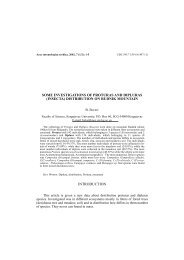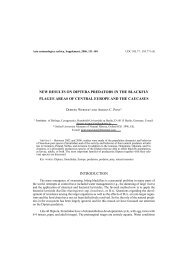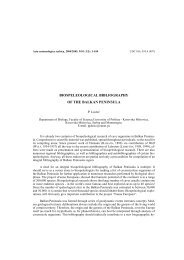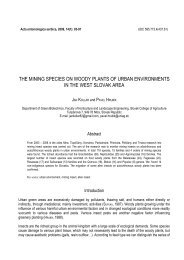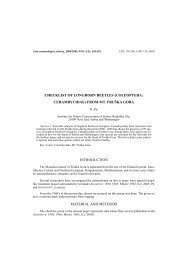Ćetković, A., Mokrousov, M., Plećaš, M., Bogusch, P., Antić, D ...
Ćetković, A., Mokrousov, M., Plećaš, M., Bogusch, P., Antić, D ...
Ćetković, A., Mokrousov, M., Plećaš, M., Bogusch, P., Antić, D ...
You also want an ePaper? Increase the reach of your titles
YUMPU automatically turns print PDFs into web optimized ePapers that Google loves.
Status of Asian Sceliphron spp. in Europe 93<br />
updated concise overview of the entire European range, since all recent reviews are partly deficient in that<br />
respect (e.g. DAISIE, 2008b, 2009; RASPLUS, 2010; RASPLUS et al., 2010; BARBIER, 2011; CABI, 2011a).<br />
Furthermore, given the current state, that the eastward spreading of both species in Europe could soon<br />
extend their allochtonous ranges into western Asia, it was of interest to include a brief consideration of the<br />
known western limits of their native ranges in Asia.<br />
Material and Methods<br />
The specimens listed in this paper are derived from several sources and collected partly by the co-authors,<br />
but also by a number of other persons in different periods and countries, most of them not particularly<br />
dedicated to the Sphecidae as a target taxon. Therefore, although not initially designed as a focused study of<br />
invasive species, this non-systematic accumulation of new data (including some important published records<br />
and other circumstantial facts) enabled a more comprehensive survey.<br />
Some of the co-authors studied separate parts of the listed material, and also numerous other specimens (for<br />
comparative purposes) from the territories outside the focal area treated herewith; they are not listed, but are<br />
conveniently mentioned in respective sections. Some of the listed records are based only on the co-authors’<br />
observations in the field (mainly in the period after 2000) in cases when reliable identification was possible. A<br />
few records (of S. curvatum) are based only on collected or observed nest-cells where there was no<br />
possibility to examine adults, and they were used only for the areas where there is a minor chance that both<br />
species can occur.<br />
Depositories of the studied material, listed herewith, are:<br />
BGFB – University of Belgrade, Faculty of Biology collection (Belgrade, Serbia)<br />
BOGU – Petr <strong>Bogusch</strong> personal collection (Hradec Králové, Czech Republic)<br />
ĆETK – Aleksandar <strong>Ćetković</strong> personal collection (Belgrade, Serbia)<br />
HLAV – Peter Hlavač personal collection (Košice, Slovakia)<br />
LINZ – Biologiezentrum / Oberösterreichische Landesmuseen (Linz, Austria)<br />
MMOK – Mikhail <strong>Mokrousov</strong> personal collection (Nizhniy Novgorod, Russia)<br />
In addition, several records are based on numerous photographs available from diverse internet forums (as a<br />
particularly valuable growing source of contemporary data), principally from:<br />
Opredelenie perponchatokrylykh (osy, pchely, murav’i) [Identification of hymenopterans (wasps, bees, ants)]<br />
(http://molbiol.ru/forums/lofiversion/index.php/t133599.html);<br />
HymIS forum (http://www.forum.hymis.de);<br />
Le monde des insectes (http://www.insecte.org/forum);<br />
Forum Entomologi Italiani (http://www.entomologiitaliani.net/public/forum/phpBB3/viewforum.php?f=135);<br />
Biodiversidad Virtual (http://www.biodiversidadvirtual.org/insectarium/Subfamilia-Sceliphrinae-Chalybion-<br />
Sceliphron-cat17006.html).<br />
We regarded these records as published, and we referenced them accordingly (sometimes only by the<br />
members-defined pseudonyms, as available), regardless of the fact that some have been incorrectly<br />
identified, or even not identified. All other published records for the focal areas are also included in the list,<br />
assuming that all/most of them are correctly identified. Also, we consulted the comprehensive map compiled<br />
by BITSCH & BARBIER (BARBIER, 2011), from the electronic Atlas Hymenoptera (Sphecidae)<br />
(http://zoologie.umh.ac.be/hymenoptera/page.asp?ID=1), for additional data in western Europe.



